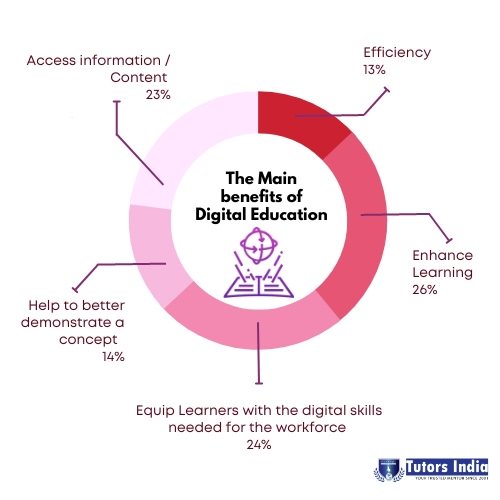CATEGORIES, TECHNOLOGIES, AND INSTRUCTIONAL METHODS FOR DIGITAL LEARNING
Introduction
In today’s world, technology is a popular topic. Without question, it has swept the globe. Technology impacts every part of our lives, including cooking, communication, travelling, sports, and governance. Technology is dynamic, and it takes the right abilities to adjust to this dynamic. We can only arm ourselves and adapt to technological changes through education. Therefore, education cannot fall behind while the rest of society adopts digital transformation. As a result, the field of education has undergone revolutionary upheaval due to technological advances (Mahmood, 2021).
The result of technology is digital e-learning. It is distinct from online learning or even just digital learning, though. Students who participate in digital learning do so with digital tools. Online courses, audio-video lectures, study materials, textbooks, and reference notes are all possible. It combines blended learning with online learning. On the other hand, digital e-learning is a method of knowledge that is entirely dependent on and made more accessible by electronic content. Teachers and students solely interact virtually and communicate with the aid of electrical devices.

Figure1: Benefits of Digital education
Digital e-learning is now a reality because of the Internet and AI innovation, which have revolutionized the field of education. There are various kinds of digital learning strategies, including:
Adaptive Education – Artificial intelligence is used to control and direct adaptive learning. Based on her responses to questions, adaptive learning determines a student’s degree of understanding, her areas of strength, and her areas of weakness. Then, it offers a systematic delivery of simple knowledge for the students to comprehend (Sailer et al., 2021).
Gamification and Badging – A student is given digital badges for her academic performance in gamification, a motivated learning strategy. Students remain motivated to learn because to the incentive of group badges.
E-Textbook – Traditional textbooks have been modernized and updated as e-textbooks. According to numerous research studies by universities and other educational institutions, E-textbooks are expected to overtake traditional books in the near future. However, e-textbooks are preferable since they are less expensive, convenient to use and handle, non-perishable, and simple to update to reflect new circumstances.
Blended Learning – Combining the best elements of traditional and online learning is known as blended learning. Both in-person and online classes are used to train students in this situation.
Online Learning – With the Internet, online education allows learners to expand their knowledge. For example, an online learner can access on-demand lectures; most lessons are pre-recorded (Nambiar, 2020).
Computer and digital technology in the classroom
With modern technology like virtual reality, 3D printing, cloud computing, and augmented social networking reality, classrooms are being updated. By shielding them from distractions, these devices assist in keeping pupils interested in their studies. Teachers have noticed that kids can comprehend their lessons more effectively using digital technologies. It also aids in a student’s rapid comprehension and recall of the subjects they have acquired.
Interactive Whiteboards – With interactive whiteboards, images from a computer can be projected using a digital projector onto a sizable board that is mounted to the wall. It allows users to interact with the board’s information using their fingertips or a pen.
Software Applications – To aid students in their learning process, numerous applications are accessible. These programs are created to run on smartphones, tablets, or PCs.
The Internet also provides all of the online services that were not previously accessible, such as blogs, wikis, podcasts, and so on.
Benefits of Teaching in a Digital Age
Today, education is almost conducted online. The popularity of a platform that gives teachers the tools they need to teach online has increased in response to the demand for online education. A teacher must remember a few things when teaching in the digital age (Miller et al., 2020).
Consider things from a student’s viewpoint – A teacher must consider the perspective of their students when teaching an online course. This aids in the teacher’s comprehension of the needs of the pupils and what will make learning more understandable for them.
Technology is used extensively – A teacher in an online class must utilize technology that supports online learning, such as video lectures, animation, and even movies, for courses like the humanities.
Education in the Digital Age
As important as instruction is, learning is a talent. The initial requirement for learning is a willingness to learn. When learning through a digital media, a learner needs to be aware of a few factors.
Eliminate Distractions – Like the universe, the digital world has no end. When learners access the Internet for educational purposes, they frequently waste time on pointless websites and apps, such as social networking. But pupils must be persistent in their resolve to avoid diversion.
Don’t use too many sources – Choosing worthwhile materials for focused learning can be challenging because there is no shortage of study material available online. However, one must take care to avoid overload and maintain a finite pool of learning resources (Baticulon et al., 2021).
Digital e-learning, online learning, or digital learning– There are countless possibilities to learn and develop through all these educational methods. Anyone can know anything and gain expertise in their field of interest with digital learning. Online education provides equal learning opportunities for both men and women, young and elderly (Llerena-Izquierdo et al., 2020).
Thus, the proportion of students using online technologies to supplement their education is steadily rising. The growing trend suggests that as more things get digitized, there will be an increase in the number of students using these digital resources.
At tutors India, we offer dissertation writing assistance on e-learning, cisco digital learning, and advantages of e-learning to researchers, kindly get in touch with Tutors India. Further, for writing a thesis, without a doubt, you can always reach out to Tutors India.
References
Baticulon, R.E., Sy, J.J., Alberto, N.R.I., Baron, M.B.C., Mabulay, R.E.C., Rizada, L.G.T., Tiu, C.J.S., Clarion, C.A. & Reyes, J.C.B. (2021). ”Barriers to Online Learning in the Time of COVID-19: A National Survey of Medical Students in the Philippines”, Medical Science Educator, 31 (2). 615–626.
Llerena-Izquierdo, J., Barcia-Ayala, O. & Ayala-Carabajo, R. (2020). ”Faculty Training through Crowdlearning for Emerging Online Education”. In: 2020 IEEE ANDESCON. 13 October 2020, IEEE, 1–7.
Mahmood, S. (2021). ”Instructional Strategies for Online Teaching in COVID 19 Pandemic”, Human Behavior and Emerging Technologies, 3 (1). 199–203.
Miller, T., MacLaren, K. & Xu, H. (2020). ”Online learning: Practices, perceptions, and technology”, Canadian Journal of Learning and Technology, 46 (1).
Nambiar, D. (2020). ”The impact of online learning during COVID-19: students’ and teachers’ perspective”, The International Journal of Indian Psychology, 8 (2). 783–793.
Sailer, M., Murböck, J. & Fischer, F. (2021). ”Digital learning in schools: What does it take beyond digital technology?”, Teaching and Teacher Education, 103. 103346.

 Previous Post
Previous Post Next Post
Next Post